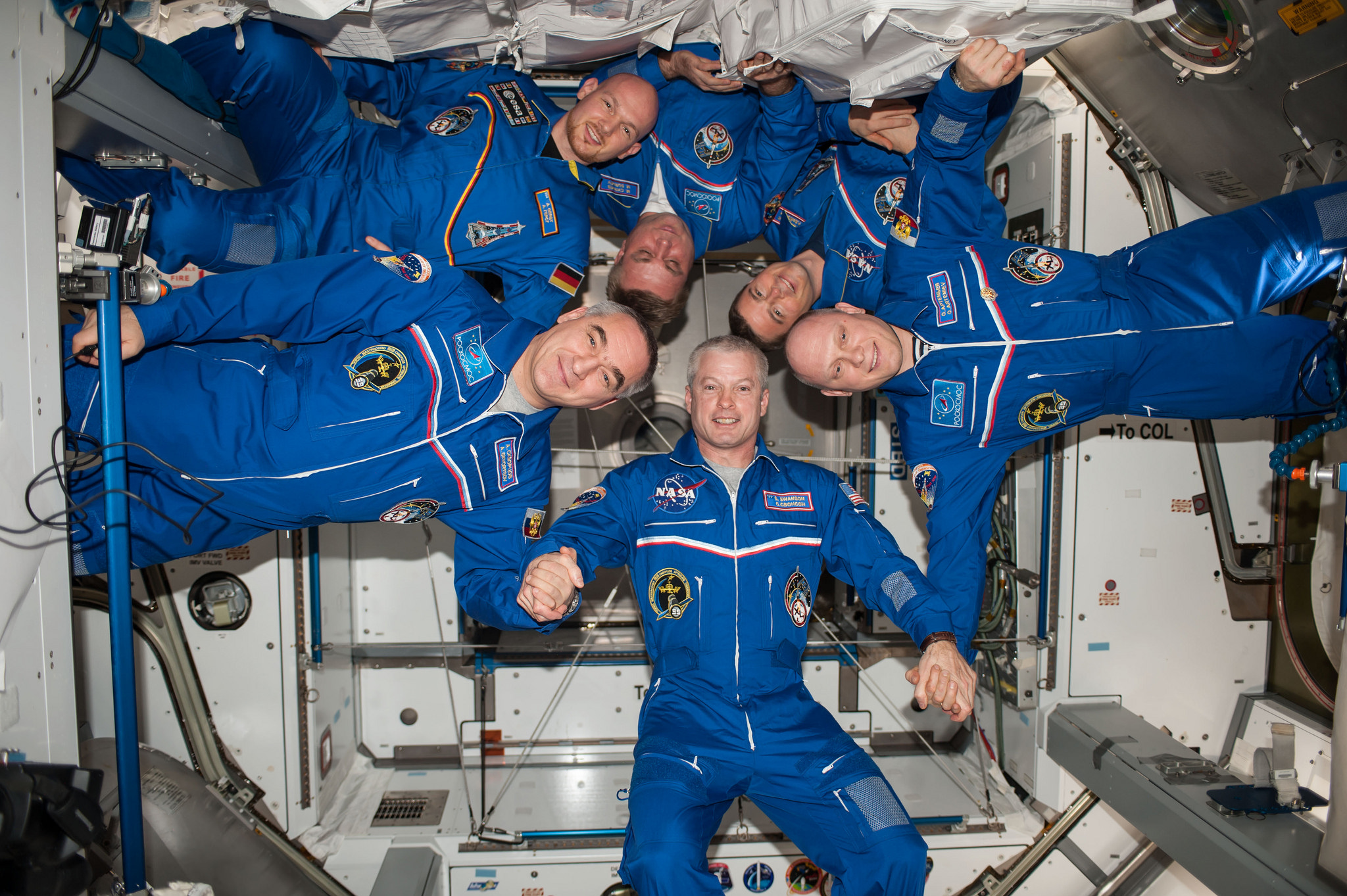
More than five months since their feet last touched terra firma, the Soyuz TMA-12M crew of U.S. astronaut Steve Swanson and Russian cosmonauts Aleksandr Skvortsov and Oleg Artemyev are primed to depart the International Space Station (ISS) late Wednesday, 10 September, and return to Earth. Current plans envisage the three men undocking from the station’s space-facing (or “zenith”) Poisk module at 7:02 p.m. EDT Wednesday, after which they will discard the orbital and instrument modules of their Soyuz spacecraft, before embarking on the perilous descent back through the atmosphere to a parachute-assisted landing in Kazakhstan. The Soyuz TMA-12M descent module is expected to hit the Kazakh steppe—with solid-fueled rockets cushioning the touchdown—at 10:25 p.m. EDT (8:25 a.m. local time Thursday, 11 September) to draw down the curtain on a hugely successful Expedition 39/40.
Launched from the Baikonur Cosmodrome in Kazakhstan at 3:17 a.m. local time on 26 March (5:17 p.m. EDT on 25 March), Soyuz TMA-12M was originally intended to execute a six-hour, four-orbit “fast rendezvous” profile to reach the ISS and boost its incumbent Expedition 39 crew up to a full, six-man strength. Riding a descendent of Chief Designer Sergei Korolev’s R-7 rocket into orbit, Swanson, Skvortsov, and Artemyev were notified of the transition from terrestrial gravity to microgravity when a green and yellow toy duck—nicknamed “Quack” and provided by Skvortsov’s young daughter, which they had hung from their instrument panel—began to float for the first time.
However, the opening hours of the mission did not go according to plan. Four critical maneuvering system firings were scheduled to bring Soyuz TMA-12M into position for an on-time docking at the ISS. Two of these burns were successfully performed, but software problems arose before the planned execution of the third burn. Since there existed very little time margin within the compressed schedule for a correction maneuver, Russian flight controllers were left with no option but to cancel the fast rendezvous profile and revert to a “default” rendezvous regime, lasting two days and 34 orbits. Under this new profile, Soyuz TMA-12M docked successfully at the space station’s Poisk module at 7:53 p.m. EDT on 27 March, a little over 50 hours since departing Baikonur.
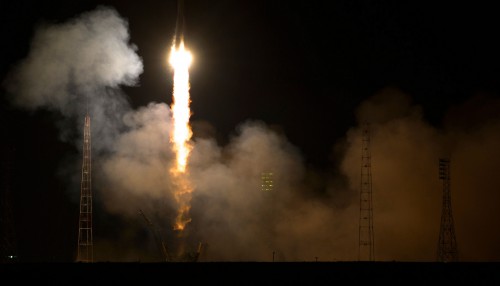
The three new arrivals were welcomed aboard the ISS by Expedition 39 Commander Koichi Wakata—the station’s first Japanese skipper—and crewmates Rick Mastracchio of NASA and Russia’s Mikhail Tyurin. Although Swanson posed for an early photograph in the multi-windowed cupola, there was little time to acclimatize to their new surroundings, for a packed schedule of visiting vehicles lay ahead. SpaceX’s third dedicated Dragon cargo mission (SpX-3), having already been postponed from mid-March, eventually rose from Earth on 18 April and was robotically captured and berthed at the Earth-facing (or “nadir”) port of the station’s Harmony node on Easter Sunday, 20 April. It spent almost a month in space, before being unberthed and returned to Earth on 18 May.
However, the SpX-3 launch delay pushed Orbital Sciences’ ORB-2 Cygnus cargo mission—named in honor of former Orbital engineer and five-time shuttle astronaut, the late Janice Voss—from 6 May until mid-June at the earliest, and eventually into the first half of July. An AJ-26 engine, similar to those earmarked to power ORB-2’s Antares booster into orbit, exploded on the test stand during an acceptance firing at NASA’s Stennis Space Center in Hancock County, Miss., in May, and Orbital Sciences elected to postpone their mission until such time as the problem had been rectified. At length, ORB-2 roared into space on 13 July and was successfully berthed at the Harmony nadir interface on 16 July. Like the SpX-3 Dragon, ORB-2 remained attached to the ISS for about a month, before being robotically unberthed on 15 August. However, unlike Dragon, Cygnus was not designed to survive re-entry and instead burned up in the atmosphere on 17 August.
Dovetailed into the Dragon and Cygnus manifest, Russia also launched a pair of Progress resupply craft toward the ISS. At the time of the arrival of Swanson, Skvortsov, and Artemyev, two Progresses were already in residence: Progress M-21M, launched in November 2013, which was docked at the aft longitudinal port of the Zvezda service module, and Progress M-22M, launched in February 2014, which was docked at the nadir port of the Pirs module. Although delivered into orbit later than its mate, Progress M-22M was undocked on 7 April for several days of free-flying tests of the new Kurs-NA (“Course”) navigation system, prior to being deorbited and destroyed in the upper atmosphere on 18 April. Its berth at the Pirs nadir interface was taken on 9 April by the incoming Progress M-23M cargo ship.
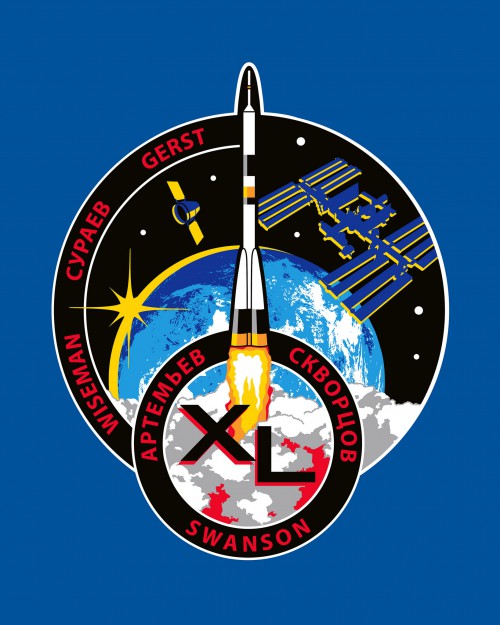
Shortly afterwards, on 23 April, Progress M-21M undocked from the Zvezda aft port, after more than 144 days in residence, but its own mission was not yet completed. It spent the next two days in independent flight, executing a series of scientific and technical experiments, before redocking on 25 April and remaining in place until it finally undocked on 9 June and was deorbited. Seven weeks later, on 21 July, Progress M-23M was itself undocked and deorbited to make room for Progress M-24M—the current and incumbent Russian cargo ship—launched into orbit on 23 July. Not only did this mission accomplish a successful fast-rendezvous profile, but it also reached the space station just five hours and 47 minutes after leaving Baikonur, which established it in third place on the list of quickest ISS-bound Progresses. Progress M-24M is presently docked at the Pirs nadir interface and will remain there until late October.
Also delivered recently to the ISS has been the European Space Agency’s (ESA) fifth and final Automated Transfer Vehicle (ATV-5), named in honor of the Belgian priest and astronomer Georges Lemaître. It was launched atop an Ariane 5 booster from the Guiana Space Centre in Kourou, French Guiana, on 29 July, and after a two-week rendezvous campaign, docked automatically at the Zvezda aft longitudinal port on 12 August. It will remain in place until the end of January 2015.
In addition to the flow of visiting vehicles, Swanson and Mastracchio were called upon to perform a contingency EVA, following the 11 April failure of a backup Multiplexer-Demultiplexer (MDM) on the station’s Mobile Base System (MBS). The failed unit represented one of more than a dozen aboard the Integrated Truss Structure (ITS) and carried responsibility for routing commands to various systems, including the cooling system, radiators, and the MBS itself. Its failure occurred during a routine health check of the EXT-2 box, which provided backup support for a prime component on the central S-0 truss. Attempts to reboot the MDM were unsuccessful and Mission Control deemed the component as lost. Its prime sibling remained fully functional, but the potentially detrimental impact upon ISS operations in terms of “fault-tolerant redundancy” necessitated an EVA. It was recognized that a redundant control path of ISS robotics was a prerequisite for the safe grappling of visiting vehicles, including Dragon and Cygnus.
Described by ISS Program Manager Mike Suffredini as one of the simplest and least complex of the so-called “Big 12” EVA tasks—which all expedition crews train to perform in order to hedge against the loss of critical station components—the removal and replacement of the failed MDM was assigned to Mastracchio and Swanson, both of whom were seasoned spacewalkers. Mastracchio already had eight EVAs under his belt, including two during Expedition 38/39, whilst Swanson had performed four spacewalks during his two previous shuttle missions.
Although the EVA was baselined for 2.5 hours, the spacewalkers completed their tasks with crispness, spending just 96 minutes outside the ISS on 23 April, in one of the shortest EVAs ever undertaken by U.S. astronauts. They even paused at one stage to acquire the first-ever photographs of a berthed Dragon cargo craft (the newly-arrived SpX-3) from a spacewalker’s perspective. Carrying their tools and the 50-pound (22-kg) replacement MDM in an Orbital Replacement Unit (ORU) bag, Mastracchio and Swanson swiftly translated from the Quest airlock to the S-0 worksite and were in position just 15 minutes into the EVA. By the one-hour mark, they had replaced the MDM and the new device had been powered up and appeared to be running normally.
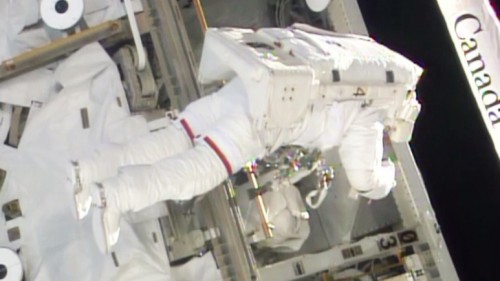
Despite the brevity of the EVA, it was just long enough for Mastracchio to pip Russian cosmonaut Fyodor Yurchikhin and become the world’s fifth most experienced spacewalker. Yurchikhin, who now sits in sixth place, has a cumulative 51 hours and 53 minutes outside, whilst the 23 April EVA allowed Mastracchio to jump to a career total of 53 hours and four minutes. Only four other human beings—Anatoli Solovyov, Mike Lopez-Alegria, Jerry Ross, and John Grunsfeld—have spent more time outside a spacecraft in a pressurized suit. Not to be outdone, Swanson, completing his fifth career EVA, totaled 27 hours and 58 minutes by the time he re-entered the Quest airlock.
Following the standard “indirect rotation” ISS crewing protocol, the Expedition 39 “core” team of Wakata, Mastracchio, and Tyurin boarded their Soyuz TMA-11M spacecraft and returned to Earth on 14 May, concluding 188 days in space and leaving Swanson in command of the new Expedition 40 with Skvortsov and Artemyev. They worked as a three-man crew for the next two weeks, until Soyuz TMA-13M was launched on 28 May, carrying Russian cosmonaut Maksim Surayev, U.S. astronaut Reid Wiseman, and Germany’s Alexander Gerst. As well as achieving a docking just six hours and four orbits after launch, the arrival of the newcomers boosted Expedition 40 to six-man strength through the summer.
In addition to the regular relay of visiting vehicles, two EVAs were performed by Skvortsov and Artemyev from the Russian Orbital Segment (ROS). The first, on 19 June, ran for seven hours and 23 minutes and involved the two cosmonauts installing an Automated Phased Antenna Array (AFAR) to form part of the Russian command and telemetry system. Skvortsov and Artemyev also relocated a component of the Obstanovka charged-particle and plasma experiment, collected samples from one of Zvezda’s windows and completed several other tasks. Returning inside the ISS, the men concluded the 33rd longest EVA in history and the fourth-longest Russian EVA. Skvortsov and Artemyev are presently exceeded in duration by last December’s eight-hour-seven-minute EVA by Expedition 38 cosmonauts Oleg Kotov and Sergei Ryazansky, the seven-hour-41-minute spacewalk performed by Expedition 15 crewmen Fyodor Yurchikhin and Clay Anderson in July 2007, and a seven-hour-29-minute excursion by Yurchikhin and Aleksandr Misurkin in August 2013.
More recently, on 18 August, Skvortsov and Artemyev spent five hours and 11 minutes in open space, deploying a Peruvian nanosatellite, installing and retrieving experiment packages and photographing the condition of multi-layered insulation on the ROS. This marked the 181st spacewalk dedicated to ISS construction and maintenance since the inaugural EVA by U.S. astronauts Jerry Ross and Jim Newman to install power cables and utilities from the Unity node to the Zarya control module, way back in December 1998.
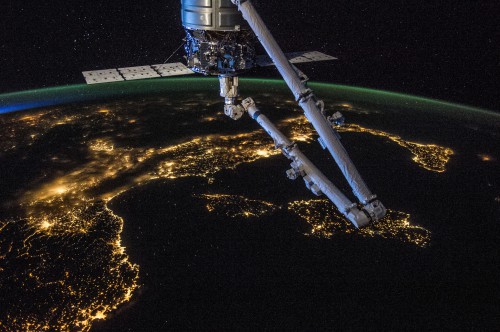
With so much emphasis upon the excitement and drama of visiting vehicles and EVAs, attention should not be distracted from the enormous scientific yield of Expedition 39/40. Earth remote sensing, assessments of human behavior and performance, and studies of animal biology and bone and muscle physiology have characterized much of the research performed over the summer of 2014. Additionally, technology demonstrations and investigations into the physical and space sciences, as well as numerous educational activities, filled the crew’s time. In terms of public outreach, they have proven particularly enthusiastic on Twitter, with daily images of Earth and life in orbit tweeted back to their followers back home. With U.S. and German astronauts, they also watched the World Cup match between the United States and Germany and, later, Germany’s triumphant win on 13 July against Argentina. The Expedition 40 crew have also spoken to many individuals, from friends and family to students to scientists, and were recently serenaded from Mission Control with a chorus of “I Won’t Give Up” by singer-songwriter Jason Mraz.
In order to physiologically prepare themselves for the transition from microgravity back to terrestrial gravity, Swanson, Skvortsov, and Artemyev have intensified their Lower Body Negative Pressure (LBNP) training and exercise regimes in recent days. They also extensively tested the control systems aboard their Soyuz TMA-12M spacecraft. In traditional fashion, Swanson will ceremonially hand command of the space station to Surayev, ending Expedition 40 and kicking off Expedition 41, during a televised address at about 5:15 p.m. EDT Tuesday, 9 September.
Their last day in space will be spent packing equipment and personal items, with the final closure of hatches between Soyuz TMA-12M and the ISS currently expected at 3:35 p.m. EDT Wednesday. Assuming an on-time undocking at 7:02 p.m., the deorbit burn—lasting about 4.5 minutes in duration—will be performed at 9:31 p.m. to begin the perilous descent back through the “sensible” atmosphere. Soyuz TMA-12M’s spherical orbital module and cylindrical instrument module will be jettisoned, leaving Swanson, Skvortsov, and Artemyev confined to the beehive-shaped descent module for the fiery plunge to Earth.
They will touch down near the city of Dzhezkazgan, within Kazakhstan’s central uplands, at 10:25 p.m. EDT Wednesday (8:25 a.m. local time Thursday), completing a mission of 169 days, five hours, and eight minutes. Helicopters bearing Russian and NASA recovery personnel will reach the landing site shortly afterwards to assist the crew and begin detailed medical examinations. In the aftermath of landing, Swanson will likely return directly to Ellington Field in Houston, Texas, aboard a Gulfstream III aircraft, whilst Skvortsov and Artemyev will be flown back to the cosmonauts’ training center of Star City, on the outskirts of Moscow.
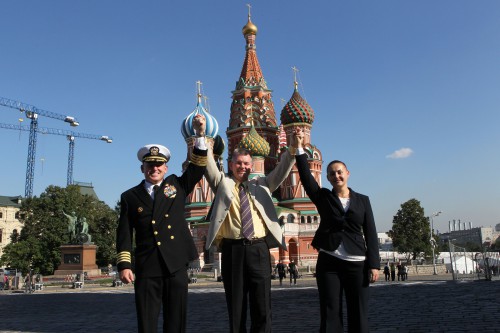
Assuming an on-time landing, Swanson will have accrued a career total of 195 days, 20 hours, and 49 minutes, spread across his two shuttle flights—STS-117 in June 2007 and STS-119 in March 2009—and Expedition 39/40. His 96-minute EVA with Rick Mastracchio has also established him in 53rd place on the list of the world’s most experienced spacewalkers, with five excursions and 27 hours and 58 minutes spent in the vacuum of space. His crewmates, Aleksandr Skvortsov and Oleg Artemyev, having made their first two career EVAs together on Expedition 40, have both now spent a total of 12 hours and 34 minutes of spacewalking time. With a 176-day mission from April-September 2010 to his credit, Skvortsov will have increased his personal space time to 345 days, six hours, and 27 minutes at the close of Expedition 40, placing him in 36th place on the list of most experienced spacefarers of all time, just behind the 347-day total of Japanese astronaut Koichi Wakata and slightly ahead of the 341-day tally of Kazakh cosmonaut Talgat Musabayev.
With the departure of Swanson, Skvortsov, and Artemyev, the new Expedition 41 will operate at a reduced, three-man strength of Maksim Surayev, Reid Wiseman, and Alexander Gerst for about two weeks. At 4:24 p.m. EDT on 25 September (2:24 a.m. local time on 26 September), Soyuz TMA-14M is scheduled to launch from the Baikonur Cosmodrome, carrying cosmonauts Aleksandr Samokutyayev and Yelena Serova—the latter of whom will become only the fourth Russian female spacefarer and only the second to embark on a long-duration mission—together with NASA astronaut Barry “Butch” Wilmore.
They will dock at the ISS about six hours into their mission and bring Expedition 41 up to six-person capability, for a fall which is literally packed with activity: SpaceX’s SpX-4 Dragon cargo mission, currently targeted for launch on 19 September, followed by Orbital Sciences’ ORB-3 Cygnus in mid-October and Russia’s Progress M-25M in late October. Two EVAs from the U.S. Orbital Segment (USOS) were originally slated for August 2014 to transfer a failed pump module to a long-term storage location on the ISS truss and replace a solar array electrical component. Both spacewalks—originally assigned to Swanson/Wiseman and Wiseman/Gerst—were deferred to Expedition 41, due to the need to replace long-life batteries in the U.S. Extravehicular Mobility Units (EMUs) and are now expected to be performed by Wiseman/Gerst and Wiseman/Wilmore in October. Samokutyayev and Surayev will also make a ROS-based spacewalk in October.
Want to keep up-to-date with all things space? Be sure to “Like” AmericaSpace on Facebook and follow us on Twitter: @AmericaSpace



